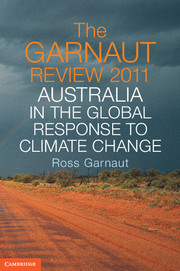Chapter 10 - Transforming the land sector
Published online by Cambridge University Press: 05 January 2012
Summary
Global food security has been a hot topic since the large spike in world food prices in 2008. Between 2006 and 2008, global food prices rose by 60 per cent. The spike is estimated to have increased by 100 million the number of people considered to be ‘food insecure’. Demonstrations and riots occurred in more than 30 countries across the Middle East, Africa, Asia and Latin America, and in Haiti food riots led to the toppling of the prime minister.
Global food prices eased following the Great Crash of 2008. The easing was brief. Prices again surged in 2010 and have risen to new heights in the first months of 2011. They were one factor behind political unrest in the Middle East in the Australian summer of 2010–11.
One long-term source of upward pressure on food prices has been strong growth in demand for high-quality food with economic growth in China and other successful developing countries, recently reinforced by climatic disruption in China and South Asia. The high food prices over the past year have been driven also by an unusual range of other severe climatic events affecting global agriculture: dry conditions in the United States; floods in Australia, Canada, Pakistan and Brazil; dry conditions in Argentina; and high temperatures, drought and wildfires in Russia. Once world grain prices started to rise strongly, the increase was exacerbated by a number of countries, most importantly Russia in the recent episode, seeking to enhance their own food security by restricting exports of grain.
- Type
- Chapter
- Information
- The Garnaut Review 2011Australia in the Global Response to Climate Change, pp. 131 - 148Publisher: Cambridge University PressPrint publication year: 2011

